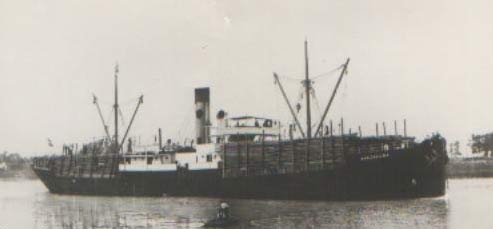|
|
Project Rainbow: What really happened in the Philadelphia experiment?
Aman named Al Bielek, who claimed to be a test subject of various secret U.S. Military Experiments, said that on August 12, 1943, the U.S. Navy carried out an experiment called the “Philadelphia Experiment” on the USS Eldridge, at the Philadelphia Naval Shipyard, after installing special equipment on it. In this test, they allegedly send the ship and all its crew members 10 minutes back in time, making it apparently ‘invisible’, and then bring them back to the present time.
MRU
As a consequence, many of the sailors onboard went insane, many lost their memory, some were engulfed in flames to their deaths, and others molecularly bonded with the ship’s metal structure. However, according to Bielek, he and his brother, who were aboard the experiment ship at the time, jumped off just before the time warp opened and survived without any injuries. There’s a huge argument as to whether this event is true or not. But if such an experiment really happened then it’s undoubtedly one of the eeriest mysteries in human history.
The Philadelphia Experiment: Project Rainbow
MRU CC
According to Al Bielek, August 12, 2003, is an extremely important anniversary date in the U.S. Navy’s secret World War II invisibility project known as the Philadelphia Experiment. Bielek claimed that ― on August 12, 1943 ― the Navy, after installing special equipment on the USS Eldridge, made the ship and its crew disappear from Philadelphia harbour for over 4 hours.
The exact nature of this test is open to speculation. Possible tests include experiments in magnetic invisibility, radar invisibility, optical invisibility or degaussing ― rendering the ship immune to magnetic mines. The tests were conducted, only to produce undesirable results. Afterwards, the project — supposedly called “Project Rainbow” — was cancelled.
What Really Happened During The Philadelphia Experiment?
Two separate sets of bizarre events make up the “Philadelphia Experiment.” Both revolve around a Navy Destroyer escort, the USS Eldridge, with the events taking place on two separate days in the summer and fall of 1943.
In the first experiment, an alleged method of electrical field manipulation allowed the USS Eldridge to be rendered invisible on July 22, 1943, in the Philadelphia Naval Shipyard. The second rumoured experiment was the teleportation and small-scale time travel (with the ship sent a few seconds in the past) of the USS Eldridge from the Philadelphia Naval Shipyard to Norfolk, Virginia, on October 28, 1943.
Horrible tales of mangled seamen and sailors stuck within the metal of the USS Eldridge often accompany this experiment, with the USS Eldrige reappearing seconds later in the waters around Philadelphia. Recitation of the events surrounding the second Philadelphia Experiment often includes a cargo and troop transport vessel, the SS Andrew Furuseth. The lore of the second experiment claims those on board the Andrew Furuseth viewed the USS Eldridge and it’s crew as they teleported into Norfolk momentarily before the ship returned to the waters of Philadelphia.
Prior to the mid-1950s, no rumours of bizarre activity surrounded any teleportation or invisibility experiments in North America during the 1940s, let alone in the area surrounding Philadelphia.
Carl Meredith Allen, using the alias Carlos Miguel Allende, sent a series of letters to the astronomer and writer Morris K. Jessup. Jessup authored several early UFO books including the mildly successful The Case For The UFO. Allen claimed to be on the SS Andrew Furuseth during the second experiment, witnessing the USS Eldridge emerge in the waters of Norfolk and quickly disappear into thin air.
Carl Allen supplied no proof to verify what he claimed to witness on October 28, 1943. He did win the mind of Morris Jessup, who began to champion Allen’s view of the Philadelphia Experiment. Jessup, however, died four years after his first contact with Allen from an apparent suicide.
Moving a ship weighing several thousand tons leaves an inevitable paper trail. On the date of the Philadelphia “Invisibility” Experiment, July 22, 1943, the USS Eldridge had yet to be commissioned. The USS Eldridge spent the day of the alleged teleportation experiments, October 28, 1943, safely within a New York harbour, waiting to escort a naval convoy to Casablanca. The SS Andrew Norfolk spent October 28, 1943, sailing across the Atlantic Ocean en route to the Mediterranean port city of Oran, further discrediting Carl Allen’s comments.
And in the early 1940s, the Navy did conduct experiments to make naval vessels “invisible” in the Philadelphia Naval Shipyards, but in a different manner and with a completely different set of desired results.
In these experiments, researchers ran an electric current through hundreds of meters of electrical cable around the hull of a ship to see if they could make the ships “invisible” to underwater and surface mines. Germany deployed magnetic mines in naval theatres — mines that would latch on to the metal hull of ships as they came near. In theory, this system would make the ships invisible to the magnetic properties of the mines.
Seventy years later, we are left without a shred of credible evidence for the Philadelphia Experiment(s), yet rumours persist. If you are still unconvinced, think of the situation from a different viewpoint. No incident, regardless of the horrific nature, would stall the development of teleportation technology if the military believed it feasible. Such a resource would be an invaluable front line weapon in war and the backbone of many commercial industries, yet decades later, teleportation is still caged within the realm of science fiction.
In 1951, the United States transferred the Eldrige to the country of Greece. Greece christened the ship the HS Leon, using the vessel for joint U.S. operations during the Cold War. The USS Eldridge met an unceremonious end, with the decommissioned ship sold to a Grecian firm as scrap after five decades of service.
In 1999, fifteen members of the USS Eldridge crew held a reunion in Atlantic City, with the veterans bemoaning the decades of questioning surrounding the vessel they served on.
https://mru.ink/the-philadelphia-experiment/ |
|
|
|
|
Magdalena
British Steam merchant
| Name |
Magdalena |
| Type: |
Steam merchant |
| Tonnage |
3,118 tons |
| Completed |
1923 - Craig, Taylor & Co Ltd, Stockton-on-Tees |
| Owner |
Smith, Hogg & Co Ltd, West Hartlepool |
| Homeport |
West Hartlepool |
| Date of attack |
18 Sep 1940 |
Nationality:  British British |
| |
| Fate |
Sunk by U-48 (Heinrich Bleichrodt) |
| Position |
57° 20'N, 20° 16'W - Grid AL 2881 |
| Complement |
31 (31 dead - no survivors) |
| Convoy |
SC-3 (straggler) |
| Route |
St. Johns - Sydney - Holyhead - Liverpool |
| Cargo |
4600 tons of iron ore |
| History |
Completed in June 1923 as Dutch Magdalena for NV A.C. Lensen´s Stoomvaart Mij, Terneuzen. 1932 transferred to British flag for Lensen Shipping Ltd (Cornelius A. Lensen), London. 1939 sold to Smith, Hogg & Co Ltd, West Hartlepool.
|
| Notes on event |
At 18.49 hours on 18 Sep 1940 the Magdalena (Master Frederick Allen), a straggler from convoy SC-3, was hit by one torpedo from U-48 south of Iceland and sank within ten minutes. The master, 29 crew members and one gunner were lost.
|
|
|
|
|
|
Buque llamado MAGDALENA SCHULTE, registrado con el número IMO 9743502, MMSI 563024900 es Container Ship. Actualmente navegando bajo bandera Singapore. Se construyó en 2019.
|
|
|
|
|
Wreck of the RMS Magdalena or Titanic in Rio De Janeiro.
A ship built in the same shipyard where the Titanic was born and which ironically ended on its maiden voyage as well.
Historic
One of the prides of the British shipping company Royal Mail Steam Packet Company. The Magdalena, the company's third ship with that name, took two years to build, due to a lack of materials in the post-war period. It was launched on May 11, 1948 by the Harland and Wolff shipyard in Ireland and immediately placed for passenger and cargo line service to Brazil, Uruguay and Argentina.
During his inaugural voyage in April 1949, he highlighted the ita come from Santos, with a scheduled stopover in Costa Rio de Janeiro.
January During the early morning hours of the 25th, he was already approaching the city, having the beach of Barra da Tijuca through the bombardment, when at 4:30 am, apparently due to a navigation error by one of the ship's officers, it crashed on the slab of the Islands Tijucas, where he was imprisoned despite attempts to desercathe Ochoque damaged the bow and opened a large hole in pore number 3.
Issued the S.O.S. emergency, the passengers were taken to the lifeboats as the coast is very close, but they did not abandon the ship, which remained stable attached to slab. Several Navy and private ships went to the site to help the vessel, among them: the submarine fighter Guaporé, Guaiba.
Beberibe, the tugs Triunfo, Lieutenant Cláudio and Commander Dorat, in addition to the Saturno and the national freighter Goiazlóide, the first to arrive at the site. It was through some of these ships that passengers were eventually disembarked.
Soon, the ship began to be unloaded, transferring part of its cargo to auxiliary ships, barges and tugs. With the weight alleviated and the following day's high tide, the ship re-floated, starting the slow tow by Triunfo and Comandante Dorat, into the interior of Guanabara Bay.
The entrance to Guanabara Bay is narrow and divided in half by the Laje fortress, where the currents are strong and the surface agitated by the funnel of water that enters and leaves. For it was exactly when crossing the bar, probably forced by the weight of the water that invaded cellar number 3 and the thick sea, that the Magdalena left between the bridge and the striking yellow chimney, which characterized the company. The images are impressive, looking like the ship was cut with a knife.
According to some witnesses, the boilers exploded; which doesn't seem likely, as they were muffled in the first moments of the accident, but the crash of the fracture was enormous, which must have confused the stunned witnesses. Bow and amidship quickly submerged, leaving a large smear of floating objects.
Champagne bottles, among others, were collected by the city's oarsmen for several days after the shipwreck. The stern, which continued to float and was immediately released by the tugs, which tug. they also feared being pulled to the bottom. On board were only the captain, a crew member and the chief practical of Rio de Janeiro, who were quickly rescued by a tug.
However, surprising everyone, half the ship did not sink, drifting until it ran aground in the Imbuí Beach (Niterói) in front of the bow sinking site. Captain Douglas Lee and his first immediately were blamed for the accident by the court of law and had their records suspended for two and one year respectively.
In the days after the accident, the opening left in the rear half of the ship was sealed with steel plates and the entire segment was towed to a shipyard in Rio de Janeiro, where it was scrapped. The ship's machines were sold and, for many years, served as a unit thermoelectric, generating electricity for the city of Manaus. Only having been definitively retired at the beginning of 2000. Some sources claim that windows and other devices in the cockpit were used to decorate the Jurujuba late Clube salon in Niterói.
Today, there are only a few pieces left spread over an area of sand and rock bottom, the largest parts were removed or blown up, and according to DHN (Diretoria de Hidrografia e Navegação da Marinha do Brasil), no more than wreckage is found. one meter from the bottom. So the location of the wreckage is not very easy.
Diving in the place is extremely difficult. Firstly, because it is the passage of large vessels and therefore, anchorage is prohibited. The place is a big narrowing at the entrance of the bar, so, with the movement of the tides, the currents in the place are very strong. To make matters worse, the color of the water in Guanabara Bay, which although at the bottom is not so dark, due to the agitation and mixing, is close to zero.
Source text : Naufrágios do Brasil
https://www.facebook.com/greatsealadys/posts/wreck-of-the-rms-magdalena-or-titanic-in-rio-de-janeiroa-ship-built-in-the-same-/213503137447553/ |
|
|
|
|
This post was inspired by a conversation with a reader (maybe on Facebook?) about loving Billy Zane in Titanic. He’s had a few roles that real standouts to me (Dead Calm, Only You — both modern-set — as well as frock flicks Titanic and Orlando). He’s got THOSE EYELASHES. Sadly these days he seems to be mostly doing low-budget productions, although I’m glad to see he’s working. So, with a lot of B-movie stuff, here’s beautiful Billy Zane in historical flicks:
Back to the Future (1985) & Part II (1989)
As “Match,” so called because he always chewed on a match; one of villain Biff’s gang in these time travel to the 1950s classics.
 Wide ties, high waistbands: check.
https://frockflicks.com/mcm-billy-zane/ |
|
|
|
|
Thrace and Egypt
Spread of the Egyptian Cults in Ancient Thrace
The spread of Egyptian cults in ancient Thrace is a multi-layered and continuous process of great importance for the history of the Bulgarian lands. In fact, it is a process that has lasted for more than eight centuries – from the beginning of the Hellenistic period (end of the 4th – 1st century BC) to the end of the Roman Empire (4th century) – and remains an imprint on religious beliefs of the local population. Originated from the Nile Valley, drawing on the diverse religious concepts of Ancient Egypt, the Egyptian cults have become the pinnacle of central government throughout their centuries of existence. They were adopted very quickly by ordinary people because of the soteriological nature of the Egyptian deities and the more personal connection they had with their followers. That is why we find them all over the Greco-Roman world and in particular in Thrace, where they are more or less assimilated with the local deities.
Origins of the divine family of Isis, Sarapis and Harpocrates
 
In 332 BC, when Alexander the Great conquered Egypt, the divine family of Isis and Osiris was still worshiped throughout the country, especially in the Delta region, where the new rulers, the Ptolemies, settled. The latter undertook various reforms to be accepted by the local population and especially by the influential priests of Osiris and Ptah in Memphis and of Amun in Thebes. Very soon Ptolemy I Soter (323-282 BC) and his advisers realized the need to change the structure of the divine family to adapt to the new political situation. Thus was created the new divine family, in which Osiris was replaced by Sarapis and Horus by Harpocrates. It was designed as a mirror of the Ptolemaic royal family. As the father of the family Sarapis quickly became a deity – patron of the capital Alexandria. He was considered the god of fertility, but also the lord of the Otherworld, like Osiris. Isis was the mother of the family. The hymns (aretalogies) in her honor inform us that she was considered by the Greek priests as a ruler, a solar deity, a demiurge, a mistress of the elements, a legislator, a creator of everything useful to people (writing, languages, temples, mysteries), a goddess of women and the embodiment of motherhood, protector of newborns, of harvests, mistress of destiny (Grandjean 1975: 17–21, Tacheva-Hitova 1982: 51–54). Their son Harpocrates, depicted as a naked child with a finger in his mouth, plays the role of “synnaos theos” (a deity who has no temple of his own) (Malaise 2000: 413). Greek and Latin authors perceived the finger in his mouth as a symbol of silence, not as a sign of his childish nature, as was the custom in Egypt. Harpocrates was “the one who imposes silence during the mysteries” (Plutarch, De Iside et Osiride, 378 b – c; Varron, De lingua Latina V.10; Ovide, Metamorphosis, 9, 692) and was considered as the god of silence, secrets and confidentiality.
 
Egyptian Cults outside Egypt
The newly formed “Greco-Egyptian” family was not very well received in Egypt, but it quickly found its way through the Greek cities in the Eastern Mediterranean, which remained under the rule of Alexander’s heirs. The first sanctuaries of Isis and Sarapis appeared in Piraeus, Eritrea and Halicarnassus (Bricault 2004). Ptolemy I himself pursued a policy in which he wanted to show that he still had claims to the lands of his ancestors. Thanks to a coalition between him and the others diadochi Alexander’s viceroy of Asia, Antigonus, was defeated at the battle of Ipsos, Phrygia in 301. After his defeat, Ptolemy I shared his dominions in Asia Minor with Seleucus and Lysimachus, the newly proclaimed king of Thrace. A few years after the victory (ca. 300-298), Ptolemy I gave his daughter Arsinoe II to Lysimachus. Most likely, their wedding was strengthened by certain benefits that lead to the permanent presence of the Ptolemies in southern Thrace. After Lysimachus’ death in 281, Arsinoe II married her brother, the new king of Egypt, Ptolemy II of Philadelphia (283-246). This gave him reason to expand his influence in the northern Aegean and to establish control over the Thracian cities of Enos and Maroneia. The successor of Ptolemy II – Ptolemy III Everget (246-221), who brought the Ptolemaic naval empire to its greatest supremacy, managed to conquer the entire southern Thracian coast from Abdera to Thracian Chersonese (Atanassova 2020a).
Разпространение на египетските култове в Древна Тракия през Елинистическата епоха
In fact, the entire 3rd century BC was marked by the presence of the Ptolemies in southern Thrace, which, without doubt, was a prerequisite for trade and cultural exchange. One of the most visible remnants of this presence was the penetration of Egyptian cults into the Thracian religious space. There are two main hypotheses about their penetration in Thrace. The first one claims that this was part of the Ptolemaic propaganda for supremacy in this area (Cumont 1929: 74-77). According to the other, the spread of the cult of the Egyptian deities has no political basis (Fraser 1960), but rather is due to trade ties and cultural exchange. However, modern research shows that neither hypothesis is definite and that the diffusion of Egyptian cults into Thrace was nuanced and due to various factors (Bricault 2004: 245). In the first place, it is extremely important to determine whether there was an initial penetration of the cult of Isis Pelagia “Isis of the Sea”, ie Isis, who was not part of the “divine couple”, as was the case in other areas of the Aegean.

After the middle of the 3rd century BC Isis and Sarapis were presented as a pair of deities, a model and guarantor of the power of the Ptolemies. The image of the two deities appeared on the coins of Perinthus, Southern Thrace. During this period the so-called aretalogy of Isis from Maroneia, Southern Thrace which gives information about all the qualities of the goddess (Grandjean 1975) was created. Most likely the text was written by a Greek who tried to reconcile the idea of the goddess with local beliefs. The cult spread rapidly and reached Anhialo and Messambria, which emerged as the most important center of Egyptian cults in Thrace. The study of all the monuments of this ancient city, as well as those of Anhialo, Odessa, Apollonia Pontica and Dionysopolis, is essential for understanding the influence and extent of the cult of the Isis-Sarapis couple during the Hellenistic period (Atanassova 2021).
Spread of Egyptian Deities in Ancient Thrace during the Roman Period
The imposition of Roman rule in the Thracian lands reflected as well in the spread of Egyptian cults. Roman emperors began to honor them and associate them with their royal power. Egyptian deities began to appear more and more in epigraphic monuments, sculpture and numismatics. However, from the previous studies it is not clear from which date this trend began to be felt in the roman provinces of Thrace and Lower Moesia. According to the research of M. Tacheva-Hitova, this happened during the time of Antoninus Pius (138–161 AD) and Marcus Aurelius (161–180 AD) (Tacheva-Hitova 1982: 96), i.e. relatively late compared to the other Roman provinces. In fact, according to the latest research, Egyptian cults were already worshipped in the Roman Empire during the time of the Flavians (69-96 AD) (Bricault 2020: 22). Emperor Vespasian (69-79), founder of the Flavian dynasty, used his stay in Egypt to link and legitimize his rule under the double patronage of Sarapis and Isis. The large cities of the Roman provinces began to issue coins with images of Egyptian deities in unison with the central government. However, the question arises about the degree of acceptance of Egyptian cults by the local population. Our study of the monuments of Serdica showed that the cult of Egyptian deities was not exclusively imperial and limited to the minting of coins as part of provincial policy (Атанасова 2019; Atanasova 2020). On the contrary, in Serdica there were real followers who believed and worshiped the deities as their own.
.

Even more obscure is the end of Egyptian cults in the Thracian lands. We know that the latest dated inscription associated with them comes from Rome of 25 May 390 (Bricault 2005: n ° 501/0212). Two years later, the great temple of Sarapis in Alexandria disappeared in flames, and with it the long history of Egyptian cults in the Greco-Roman world (Bricault 2020: 33).
https://thraceandegypt.com/en/thrace/ |
|
|
|
|
Fashion in the 80s was about strong colors, big sleeves and velvet too. Princess Diana added a bold fashion statement on that 1985 night she attended the premiere of Back to the Future in London. One of her most beloved looks too.
 
With a plum crushed velvet gown and a long V low back, signed by her beloved Catherine Walker, Diana added an extra touch by wearing her pearls with a knot also in her back. A brilliant and unforgettable fashion statement that confirms how savvy Diana was in her public appearances. She knew the photographers would be behind her when she was meeting the stars (Steven Spielberg among them) so she was aware of what she wanted people to look at. Genius. Beautiful and brilliant.
The Catherine Walker burgundy crushed velvet evening gown was also worn by Diana for the state visit to Australia.
The dress was included at the the ‘Fit For a Princess’ auction on March 15, 2013 in London, amongst other 9 dresses.

As we can see, without the pearl necklace it’s still pretty, but not as perfect.
Recently actor Michael J. Fox recalled how nervous he was to be sitting close to the princess. A weird date in which he was double nervous to be desperate to pee, but couldn’t leave or turn his back to Diana. A night he says, he’ll never forget.
 https://miscelana.com/2021/05/11/dianas-back-at-the-premiere-of-back-to-the-future/
https://miscelana.com/2021/05/11/dianas-back-at-the-premiere-of-back-to-the-future/ |
|
|
 Primer Primer
 Anterior
186 a 200 de 200
Següent Anterior
186 a 200 de 200
Següent
 Darrer
Darrer

|










 Wide ties, high waistbands: check.
Wide ties, high waistbands: check.














